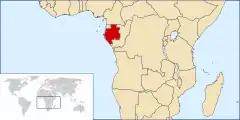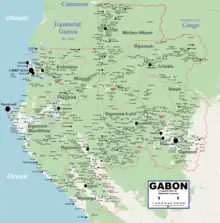Geography of Gabon
Gabon is a country in Central Africa, lying along the Atlantic Ocean, just south of the Bight of Biafra.
  | |
| Continent | Africa |
|---|---|
| Region | Central Africa |
| Coordinates | 1°00′N 11°45′E |
| Area | Ranked 77th |
| • Total | 267,667 km2 (103,347 sq mi) |
| • Land | 96.3% |
| • Water | 3.7% |
| Coastline | 885 km (550 mi) |
| Highest point | Mont Bengoué, 1070 m (not Mont Iboundji as claimed by some authorities) |
| Lowest point | Atlantic Ocean, 0 m |
| Longest river | Ogooué River |
| Climate | Tropical monsoon ('Am'), Tropical savanna ('Aw'); always hot, humid |
| Terrain | narrow coastal plain; hilly interior; savanna in east and south |
| Natural resources | Petroleum, natural gas, diamond, niobium, manganese, uranium, gold, timber, iron ore, hydropower |
| Environmental issues | deforestation, poaching |


Borders
Gabon has a total of 3,261 km of international boundaries. It borders Equatorial Guinea (335 km) and Cameroon (349 km) to the north and the Republic of the Congo (2,567 km) to the east and south. Gabon lies on the equator.
- Maritime claims
-
- Territorial sea: 12 nmi (22 km)
- Contiguous zone: 24 nmi (44 km)
- Exclusive economic zone: 200 nmi (370 km)
Terrain
| Land Use | (2012) |
|---|---|
| • Arable land | 1.26% |
| • Permanent crops | 0.66% |
| • Other | 98.08% |
Narrow coastal plain with patches of Central African mangroves; hilly interior; savanna in east and south. A recent global remote sensing analysis suggested that there were 420km² of tidal flats in Gabon, making it the 50th ranked country in terms of tidal flat area.[1]
- Irrigated land: 44.5 km2 (2003)
- Total renewable water resources: 164 km3 (2011)
Environment
International agreements:
Party to: Biodiversity, Climate Change, Desertification, Endangered Species, Hazardous Wastes, Law of the Sea, Marine Dumping, Ozone Layer Protection, Ship Pollution, Tropical Timber 83, Tropical Timber 94, Wetlands, Whaling
Climate
The equatorial location of Gabon means that it has a tropical monsoon climate (Köppen Am) and a tropical savanna climate (Köppen Aw), with the temperature being hot year-round and humid, although the Benguela Current can moderate temperatures.
| Climate data for Libreville (1961–1990) | |||||||||||||
|---|---|---|---|---|---|---|---|---|---|---|---|---|---|
| Month | Jan | Feb | Mar | Apr | May | Jun | Jul | Aug | Sep | Oct | Nov | Dec | Year |
| Average high °C (°F) | 29.5 (85.1) |
30.0 (86.0) |
30.2 (86.4) |
30.1 (86.2) |
29.4 (84.9) |
27.6 (81.7) |
26.4 (79.5) |
26.8 (80.2) |
27.5 (81.5) |
28.0 (82.4) |
28.4 (83.1) |
29.0 (84.2) |
28.6 (83.5) |
| Daily mean °C (°F) | 26.8 (80.2) |
27.0 (80.6) |
27.1 (80.8) |
26.6 (79.9) |
26.7 (80.1) |
25.4 (77.7) |
24.3 (75.7) |
24.3 (75.7) |
25.4 (77.7) |
25.7 (78.3) |
25.9 (78.6) |
26.2 (79.2) |
25.9 (78.6) |
| Average low °C (°F) | 24.1 (75.4) |
24.0 (75.2) |
23.9 (75.0) |
23.1 (73.6) |
24.0 (75.2) |
23.2 (73.8) |
22.1 (71.8) |
21.8 (71.2) |
23.2 (73.8) |
23.4 (74.1) |
23.4 (74.1) |
23.4 (74.1) |
23.3 (73.9) |
| Average rainfall mm (inches) | 250.3 (9.85) |
243.1 (9.57) |
363.2 (14.30) |
339.0 (13.35) |
247.3 (9.74) |
54.1 (2.13) |
6.6 (0.26) |
13.7 (0.54) |
104.0 (4.09) |
427.2 (16.82) |
490.0 (19.29) |
303.2 (11.94) |
2,841.7 (111.88) |
| Average rainy days | 17.9 | 14.8 | 19.5 | 19.2 | 16.0 | 3.7 | 1.7 | 4.9 | 14.5 | 25.0 | 22.6 | 17.6 | 177.4 |
| Average relative humidity (%) | 86 | 84 | 84 | 84 | 84 | 81 | 81 | 81 | 84 | 87 | 87 | 86 | 84 |
| Mean monthly sunshine hours | 175.2 | 176.8 | 176.9 | 176.8 | 159.5 | 130.6 | 119.2 | 90.4 | 95.9 | 112.9 | 134.6 | 167.8 | 1,716.6 |
| Source: NOAA[2] | |||||||||||||
| Climate data for Port-Gentil (1961–1990, extremes 1950–present) | |||||||||||||
|---|---|---|---|---|---|---|---|---|---|---|---|---|---|
| Month | Jan | Feb | Mar | Apr | May | Jun | Jul | Aug | Sep | Oct | Nov | Dec | Year |
| Record high °C (°F) | 32.6 (90.7) |
38.0 (100.4) |
34.6 (94.3) |
33.7 (92.7) |
33.2 (91.8) |
33.2 (91.8) |
30.8 (87.4) |
33.1 (91.6) |
33.3 (91.9) |
33.0 (91.4) |
34.0 (93.2) |
35.0 (95.0) |
38.0 (100.4) |
| Average high °C (°F) | 29.5 (85.1) |
30.2 (86.4) |
30.3 (86.5) |
30.0 (86.0) |
29.0 (84.2) |
26.7 (80.1) |
25.9 (78.6) |
27.4 (81.3) |
27.7 (81.9) |
28.3 (82.9) |
28.6 (83.5) |
29.0 (84.2) |
28.5 (83.3) |
| Daily mean °C (°F) | 26.9 (80.4) |
27.3 (81.1) |
27.3 (81.1) |
27.1 (80.8) |
26.6 (79.9) |
24.4 (75.9) |
23.5 (74.3) |
24.7 (76.5) |
25.4 (77.7) |
25.9 (78.6) |
26.1 (79.0) |
26.5 (79.7) |
26.0 (78.8) |
| Average low °C (°F) | 24.2 (75.6) |
24.4 (75.9) |
24.3 (75.7) |
24.2 (75.6) |
24.1 (75.4) |
22.0 (71.6) |
21.1 (70.0) |
21.9 (71.4) |
23.0 (73.4) |
23.5 (74.3) |
23.5 (74.3) |
24.0 (75.2) |
23.3 (73.9) |
| Record low °C (°F) | 17.6 (63.7) |
19.4 (66.9) |
19.5 (67.1) |
18.0 (64.4) |
19.0 (66.2) |
16.4 (61.5) |
16.0 (60.8) |
13.2 (55.8) |
18.2 (64.8) |
19.5 (67.1) |
15.8 (60.4) |
18.2 (64.8) |
13.2 (55.8) |
| Average precipitation mm (inches) | 247.8 (9.76) |
177.8 (7.00) |
266.8 (10.50) |
299.3 (11.78) |
150.6 (5.93) |
11.5 (0.45) |
3.4 (0.13) |
5.0 (0.20) |
31.8 (1.25) |
179.9 (7.08) |
352.2 (13.87) |
227.1 (8.94) |
1,953.2 (76.90) |
| Average precipitation days | 14.8 | 12.7 | 16.4 | 15.5 | 10.2 | 0.9 | 0.5 | 3.4 | 9.0 | 17.4 | 19.6 | 13.9 | 134.3 |
| Average relative humidity (%) | 84 | 84 | 83 | 84 | 85 | 84 | 83 | 82 | 82 | 84 | 86 | 84 | 84 |
| Mean monthly sunshine hours | 150.4 | 160.8 | 154.5 | 151.5 | 147.8 | 156.3 | 163.1 | 135.3 | 125.7 | 116.1 | 115.1 | 147.2 | 1,723.8 |
| Source 1: NOAA[3] | |||||||||||||
| Source 2: Meteo Climat (record highs and lows)[4] | |||||||||||||
| Climate data for Lambaréné (1961–1990) | |||||||||||||
|---|---|---|---|---|---|---|---|---|---|---|---|---|---|
| Month | Jan | Feb | Mar | Apr | May | Jun | Jul | Aug | Sep | Oct | Nov | Dec | Year |
| Average high °C (°F) | 31.5 (88.7) |
32.2 (90.0) |
32.3 (90.1) |
32.5 (90.5) |
31.3 (88.3) |
28.9 (84.0) |
27.9 (82.2) |
28.4 (83.1) |
30.0 (86.0) |
31.0 (87.8) |
30.8 (87.4) |
30.9 (87.6) |
30.6 (87.1) |
| Daily mean °C (°F) | 27.2 (81.0) |
27.6 (81.7) |
27.6 (81.7) |
27.8 (82.0) |
27.2 (81.0) |
25.3 (77.5) |
23.9 (75.0) |
24.7 (76.5) |
26.1 (79.0) |
26.9 (80.4) |
26.9 (80.4) |
27.1 (80.8) |
26.5 (79.7) |
| Average low °C (°F) | 22.9 (73.2) |
22.9 (73.2) |
22.8 (73.0) |
23.1 (73.6) |
23.1 (73.6) |
21.7 (71.1) |
19.9 (67.8) |
20.9 (69.6) |
22.2 (72.0) |
22.8 (73.0) |
23.0 (73.4) |
23.2 (73.8) |
22.4 (72.3) |
| Average precipitation mm (inches) | 175.3 (6.90) |
145.2 (5.72) |
253.8 (9.99) |
212.8 (8.38) |
162.2 (6.39) |
20.9 (0.82) |
3.2 (0.13) |
6.9 (0.27) |
71.0 (2.80) |
347.7 (13.69) |
393.9 (15.51) |
172.0 (6.77) |
1,968.9 (77.52) |
| Average precipitation days | 12.1 | 10.7 | 15.0 | 14.1 | 13.8 | 2.9 | 2.1 | 5.1 | 9.6 | 21.9 | 20.8 | 12.5 | 140.6 |
| Average relative humidity (%) | 83 | 81 | 81 | 81 | 83 | 84 | 82 | 81 | 80 | 81 | 83 | 84 | 82 |
| Mean monthly sunshine hours | 142.9 | 145.2 | 145.1 | 143.1 | 123.9 | 74.2 | 70.6 | 53.4 | 55.9 | 70.9 | 117.1 | 129.4 | 1,271.7 |
| Source: NOAA[5] | |||||||||||||
| Climate data for Makokou (1961–1990, extremes 1949–present) | |||||||||||||
|---|---|---|---|---|---|---|---|---|---|---|---|---|---|
| Month | Jan | Feb | Mar | Apr | May | Jun | Jul | Aug | Sep | Oct | Nov | Dec | Year |
| Record high °C (°F) | 34.0 (93.2) |
41.5 (106.7) |
37.0 (98.6) |
39.5 (103.1) |
41.1 (106.0) |
37.3 (99.1) |
32.5 (90.5) |
33.0 (91.4) |
35.4 (95.7) |
37.2 (99.0) |
36.0 (96.8) |
33.5 (92.3) |
41.5 (106.7) |
| Average high °C (°F) | 29.2 (84.6) |
30.1 (86.2) |
30.5 (86.9) |
30.5 (86.9) |
29.8 (85.6) |
27.7 (81.9) |
25.8 (78.4) |
26.6 (79.9) |
28.7 (83.7) |
29.2 (84.6) |
28.7 (83.7) |
27.6 (81.7) |
28.7 (83.7) |
| Daily mean °C (°F) | 24.4 (75.9) |
24.9 (76.8) |
25.2 (77.4) |
25.3 (77.5) |
24.8 (76.6) |
23.4 (74.1) |
22.2 (72.0) |
22.5 (72.5) |
24.0 (75.2) |
24.4 (75.9) |
24.1 (75.4) |
23.5 (74.3) |
24.1 (75.4) |
| Average low °C (°F) | 19.5 (67.1) |
19.7 (67.5) |
19.8 (67.6) |
20.0 (68.0) |
19.8 (67.6) |
19.0 (66.2) |
18.6 (65.5) |
18.4 (65.1) |
19.2 (66.6) |
19.5 (67.1) |
19.5 (67.1) |
19.3 (66.7) |
19.4 (66.9) |
| Record low °C (°F) | 15.9 (60.6) |
15.0 (59.0) |
16.3 (61.3) |
16.6 (61.9) |
16.8 (62.2) |
14.2 (57.6) |
11.5 (52.7) |
13.0 (55.4) |
13.5 (56.3) |
15.0 (59.0) |
17.0 (62.6) |
15.2 (59.4) |
11.5 (52.7) |
| Average precipitation mm (inches) | 88.1 (3.47) |
106.9 (4.21) |
190.0 (7.48) |
206.7 (8.14) |
187.7 (7.39) |
54.1 (2.13) |
9.0 (0.35) |
29.3 (1.15) |
142.9 (5.63) |
297.3 (11.70) |
225.7 (8.89) |
103.3 (4.07) |
1,641 (64.61) |
| Average precipitation days | 7.3 | 8.9 | 13.7 | 14.7 | 15.4 | 6.5 | 2.6 | 3.6 | 11.2 | 20.9 | 17.9 | 8.8 | 131.5 |
| Average relative humidity (%) | 82 | 79 | 79 | 79 | 80 | 83 | 85 | 83 | 80 | 80 | 81 | 83 | 81 |
| Mean monthly sunshine hours | 131.6 | 137.4 | 158.2 | 160.5 | 150.4 | 101.5 | 60.9 | 58.1 | 95.5 | 134.1 | 132.3 | 122.8 | 1,443.3 |
| Source 1: NOAA[6] | |||||||||||||
| Source 2: Meteo Climat (record highs and lows)[7] | |||||||||||||
Extreme points
- Northernmost point - unnamed location on the border with Cameroon on the Ntem River, Woleu-Ntem province
- Easternmost point - the unnamed location on the border with the Republic of Congo immediately south-west of the Congolese village of Mbeyi-Mbola, Haut-Ogooué province
- Southernmost point - the point at which the border with the Republic of Congo enters the Atlantic Ocean, Nyanga Province
- Westernmost point - the north-west point of Cape Lopez, Ogooué Maritime province


See also
References
- Murray, N.J.; Phinn, S.R.; DeWitt, M.; Ferrari, R.; Johnston, R.; Lyons, M.B.; Clinton, N.; Thau, D.; Fuller, R.A. (2019). "The global distribution and trajectory of tidal flats". Nature. 565 (7738): 222–225. doi:10.1038/s41586-018-0805-8. PMID 30568300. S2CID 56481043.
- "Libreville Climate Normals 1961–1990". National Oceanic and Atmospheric Administration. Retrieved September 10, 2015.
- "Port-Gentil Climate Normals 1961–1990". National Oceanic and Atmospheric Administration. Retrieved March 8, 2015.
- "Station Port Gentil" (in French). Meteo Climat. Retrieved 11 June 2016.
- "Lambarn (Lambaréné) Climate Normals 1961–1990". National Oceanic and Atmospheric Administration. Retrieved 6 November 2016.
- "Makokou Climate Normals 1961–1990". National Oceanic and Atmospheric Administration. Retrieved 6 November 2016.
- "Station Makokou" (in French). Meteo Climat. Retrieved 6 November 2016.
![]() This article incorporates public domain material from The World Factbook. CIA.
This article incorporates public domain material from The World Factbook. CIA.
